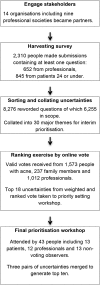Identifying acne treatment uncertainties via a James Lind Alliance Priority Setting Partnership
- PMID: 26187120
- PMCID: PMC4513497
- DOI: 10.1136/bmjopen-2015-008085
Identifying acne treatment uncertainties via a James Lind Alliance Priority Setting Partnership
Abstract
Objectives: The Acne Priority Setting Partnership (PSP) was set up to identify and rank treatment uncertainties by bringing together people with acne, and professionals providing care within and beyond the National Health Service (NHS).
Setting: The UK with international participation.
Participants: Teenagers and adults with acne, parents, partners, nurses, clinicians, pharmacists, private practitioners.
Methods: Treatment uncertainties were collected via separate online harvesting surveys, embedded within the PSP website, for patients and professionals. A wide variety of approaches were used to promote the surveys to stakeholder groups with a particular emphasis on teenagers and young adults. Survey submissions were collated using keywords and verified as uncertainties by appraising existing evidence. The 30 most popular themes were ranked via weighted scores from an online vote. At a priority setting workshop, patients and professionals discussed the 18 highest-scoring questions from the vote, and reached consensus on the top 10.
Results: In the harvesting survey, 2310 people, including 652 professionals and 1456 patients (58% aged 24 y or younger), made submissions containing at least one research question. After checking for relevance and rephrasing, a total of 6255 questions were collated into themes. Valid votes ranking the 30 most common themes were obtained from 2807 participants. The top 10 uncertainties prioritised at the workshop were largely focused on management strategies, optimum use of common prescription medications and the role of non-drug based interventions. More female than male patients took part in the harvesting surveys and vote. A wider range of uncertainties were provided by patients compared to professionals.
Conclusions: Engaging teenagers and young adults in priority setting is achievable using a variety of promotional methods. The top 10 uncertainties reveal an extensive knowledge gap about widely used interventions and the relative merits of drug versus non-drug based treatments in acne management.
Keywords: DERMATOLOGY; QUALITATIVE RESEARCH.
Published by the BMJ Publishing Group Limited. For permission to use (where not already granted under a licence) please go to http://group.bmj.com/group/rights-licensing/permissions.
Figures


References
Publication types
MeSH terms
Grants and funding
LinkOut - more resources
Full Text Sources
Other Literature Sources
Medical
Miscellaneous
